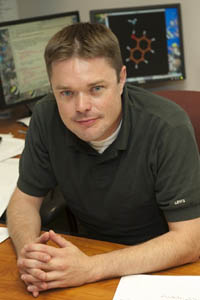John M. Herbert has received the highest award that a beginning researcher can receive in the United States.
The Ohio State University chemist is among 100 scientists and engineers honored with the 2009 Presidential Early Career Award for Scientists and Engineers (PECASE). He will receive his award in a White House ceremony later this fall.

"These extraordinarily gifted young scientists and engineers represent the best in our country," President Obama said in a statement. "With their talent, creativity, and dedication, I am confident that they will lead their fields in new breakthroughs and discoveries and help us use science and technology to lift up our nation and our world."
Herbert, assistant professor of chemistry, wants to understand what happens when complex molecules absorb light. When other chemists reach the limits of what they can learn from experiments in the laboratory, he fills in the rest of the story with computer modeling and simulation.
He was recognized for “his work in developing novel algorithms for the simulation of electronically-excited states consisting of hundreds of atoms and for applying these techniques to the characterization of photochemical processes in DNA, and for his work in developing open-ended research projects to be integrated into undergraduate teaching laboratories.”
A DNA molecule may contain millions of atoms; even modeling the electronic interactions of a few hundred atoms is a daunting task that requires high-performance computing. Herbert is developing software to help researchers study the electronic structure of large and complicated molecules.
He also plans to design software to help undergraduate students learn computational chemistry -- now a standard tool in the chemist’s toolbox.
“Chemists have always synthesized new molecules and taken measurements, but now it’s routine to also make calculations that offer molecular-level detail and enhance our understanding of those measurements,” Herbert said. “We combine aspects of chemistry, physics, math, and a little bit of computer science to come up with clever algorithms that push the frontiers of what we can tackle computationally.”
He credits the Ohio Supercomputer Center for offering him the computing power he needs to do the job. And he credits his colleagues in the Department of Chemistry for giving him new challenges.
“As a theorist, I have my head stuck in an equation most of the time,” he laughed. “I like the math and the physical aspects of chemistry. So I rely on my colleagues to tell me what molecules are interesting to them -- what questions their experimental techniques can’t seem to answer.”
The PECASE awards, established by President Clinton in 1996, are coordinated by the Office of Science and Technology Policy within the Executive Office of the President.
Nine federal departments and agencies join together annually to nominate the most meritorious young scientists and engineers -- researchers whose early accomplishments show the greatest promise for strengthening America’s leadership in science and technology and contributing to the awarding agencies' missions. Herbert was nominated by the National Science Foundation.
Awardees are selected on the basis of two criteria: Pursuit of innovative research at the frontiers of science and technology and a commitment to community service as demonstrated through scientific leadership, public education, or community outreach. Winning scientists and engineers receive up to a five-year research grant to further their study in support of critical government missions.
_________________
Written by Pam Frost Gorder, (614) 292-9475; Gorder.1@osu.edu
Contact: John H. Herbert, (614) 292-6851; Herbert.44@osu.edu